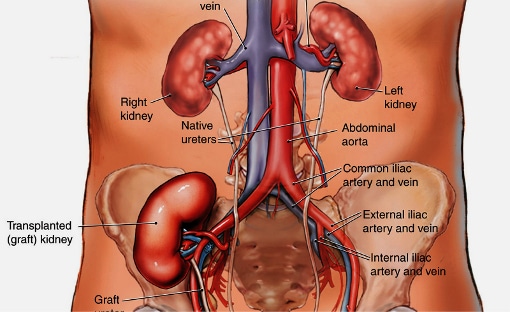A kidney transplant is the removal of a kidney from a body and placed in the body of a patient with end-stage kidney disease. A kidney transplant is also known as a renal transplant.
There are two types of kidney transplants depending on the origin of the donor organ. This classification of kidney transplant includes:
1. Deceased-donor Transplant – This is the removal of kidneys from someone who has recently died and placed in a patient with kidney failure. This is done with the consent of the family or from a donor card.
As soon as the kidney is cultivated from the deceased person, it is stored on ice to keep it alive and functioning while it is transported to the transplant center as soon as possible usually using an airplane or helicopter.
2. Living-donor Transplant – This type of kidney transplant involves the removal of a kidney from a living donor and placed in a patient with kidney failure.
One kidney can sustain an individual and perform the various functions of the kidney optimally. A living-donor kidney transplant may be divided into genetically related or non-related depending on the biological relationship between the donor and recipient.
History of Kidney Transplant
Simon Flexner, an American medical researcher was one of the earlier medical scientists to note the possibility of kidney transplants in 1907. He also noted the possibility of other organ transplants such as heart transplants, liver transplants, blood vessels, etc.
In 1933 Yuriy Voroniy, a surgeon from Kherson in the Soviet Union attempted the first human kidney transplant. He performed a deceased-donor kidney transplant on his patient who died two days later due to organ rejection.
On June 17, 1950, Dr. Richard Lawler at a hospital in Illinois, US performed the first successful kidney transplant on Ruth Tucker. Ruth lived for about five years before the transplanted kidney was destroyed due to organ rejection.
The first living-donor kidney transplant took place in 1952 at Necker Hospital in Paris by Jean Hamburger. The kidney however failed after three weeks as a result of rejection.
The next living-donor transplant procedure was between identical twins Ronald and Richard Herrick which took place in 1954 in Boston. The procedure is the first successful living-donor kidney transplant.
In 1955, Charles Rob and William James performed the first deceased-donor transplant in the UK which was unsuccessful. The first successful deceased-donor was performed by Peter Raper in the UK about eight months after the earlier attempt in 1955.
The main issue with kidney transplants between unrelated subjects is rejection by the recipient’s immune system. The immune system helps to defend the body against invading foreign bodies. After an organ transplant, the immune system classifies the transplanted kidney as a foreign body and attempts to destroy it.
Medication to suppress the immune system is therefore essential following a genetically unrelated renal transplant. The downside of immunosuppressive drugs is that it places the individual at greater risk of infection and cancer.
Why Kidney Transplant is done
A kidney transplant is regarded as the best choice of treatment for end-stage kidney disease leading to kidney failure. Various conditions can damage the kidneys including diabetes mellitus, high blood pressure and glomerulonephritis.
Why Kidney Transplant May not be done
There are risks involved with the surgery. The risks of having a kidney transplant include:
- Liver disease
- Some forms of cancers
- Concurrent tobacco use
- Morbid obesity
These are indicators that put a patient at higher risk for surgical complications.
Sources of Kidneys for Kidney Transplant
About one-third of all kidney transplants performed in the U.S. are living-donor kidney transplants. The other two-thirds involve a kidney from a deceased donor.
Since the immunosuppressive drugs to prevent rejection are so effective, donors do not need to be genetically related to their recipient.
Potential donors are carefully evaluated medically and psychologically to ensure that they are fit for surgery and have no disease which may bring about the undue risk for either the donor or recipient.
Kidneys for deceased-donor transplants are gotten from either brain-dead donors or cardiac dead donors.
Compatibility
The donor and recipient should belong to the same ABO blood group. Cross-matching should also be performed to ensure human leukocyte antigen compatibility.
If a potential living donor is incompatible with their recipients, the donor could be exchanged for a compatible kidney, a procedure known as kidney paired donation.
Procedure

Kidney Transplant Procedure
In most cases, removing the dysfunctional kidney has been found to increase the rates of surgical morbidity. Hence, the dysfunctional kidney is not removed and the transplanted is placed in a different location, usually the pelvis. This necessitates the use of different blood supplies as follows:
The renal artery of the new kidney is connected to the external iliac artery while the renal vein is connected to the external iliac vein. The donor ureter is joined to the bladder of the recipient.
Recovery from Kidney Transplant
The surgical procedure takes about three hours. The donated kidney usually starts functioning immediately. Living donors require about 3-5 days to reach normal functioning levels.
A hospital stay is usually for 4-10 days.
Diet
Kidney transplant recipients are discouraged from taking certain kinds of foods that tend to interact with the transplant medications. Examples of such foods include grapefruit, pomegranate and green tea products.
Exercise
Exercise and physical activity should be a regular part of your life after a renal transplant to continue improving your overall physical and mental health.
After a transplant, regular exercise helps boost energy levels and increase strength. It also helps you maintain a healthy weight, reduce stress and prevent common post-transplant complications such as high blood pressure and cholesterol levels.
Complications
Problems after a kidney transplant may include:
- Infection – This is due to the immunosuppressant drugs that are required to decrease the risk of rejection. This risk is not completely eradicated hence; kidney transplant patients take the immunosuppressant for the rest of their lives.
- Hypertension – There is also a risk of developing hypertension following a kidney transplant
- Proteinuria – This is the presence of abnormal quantities of protein in the urine
A patient’s age and health condition are factors that affect the risk of complications.


